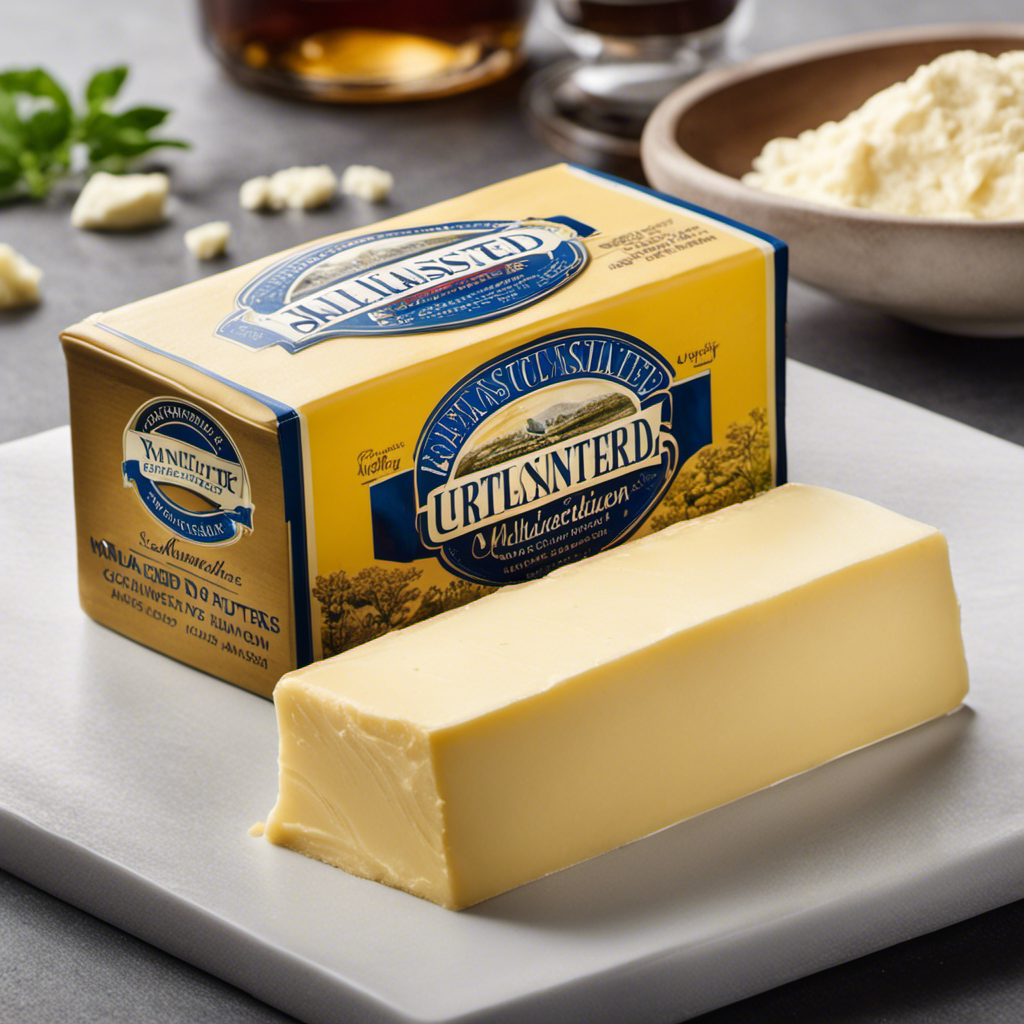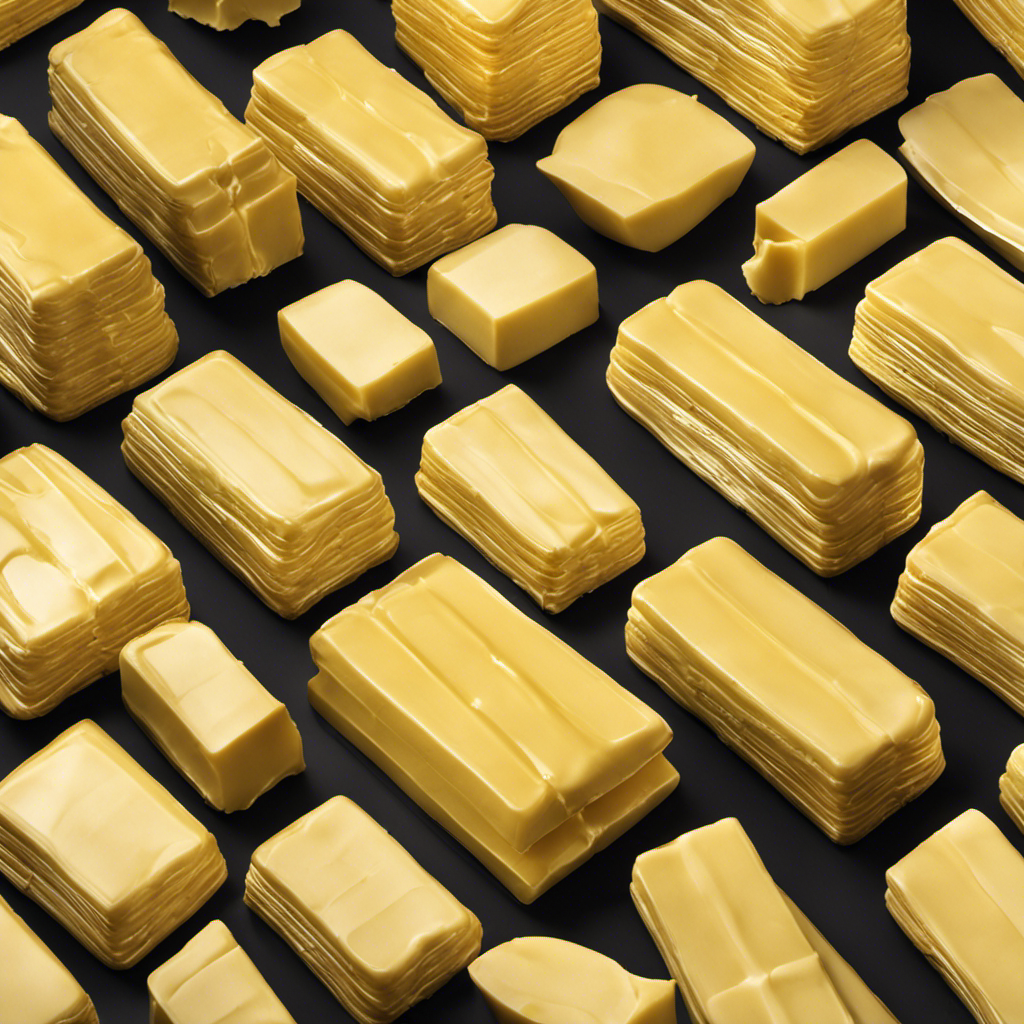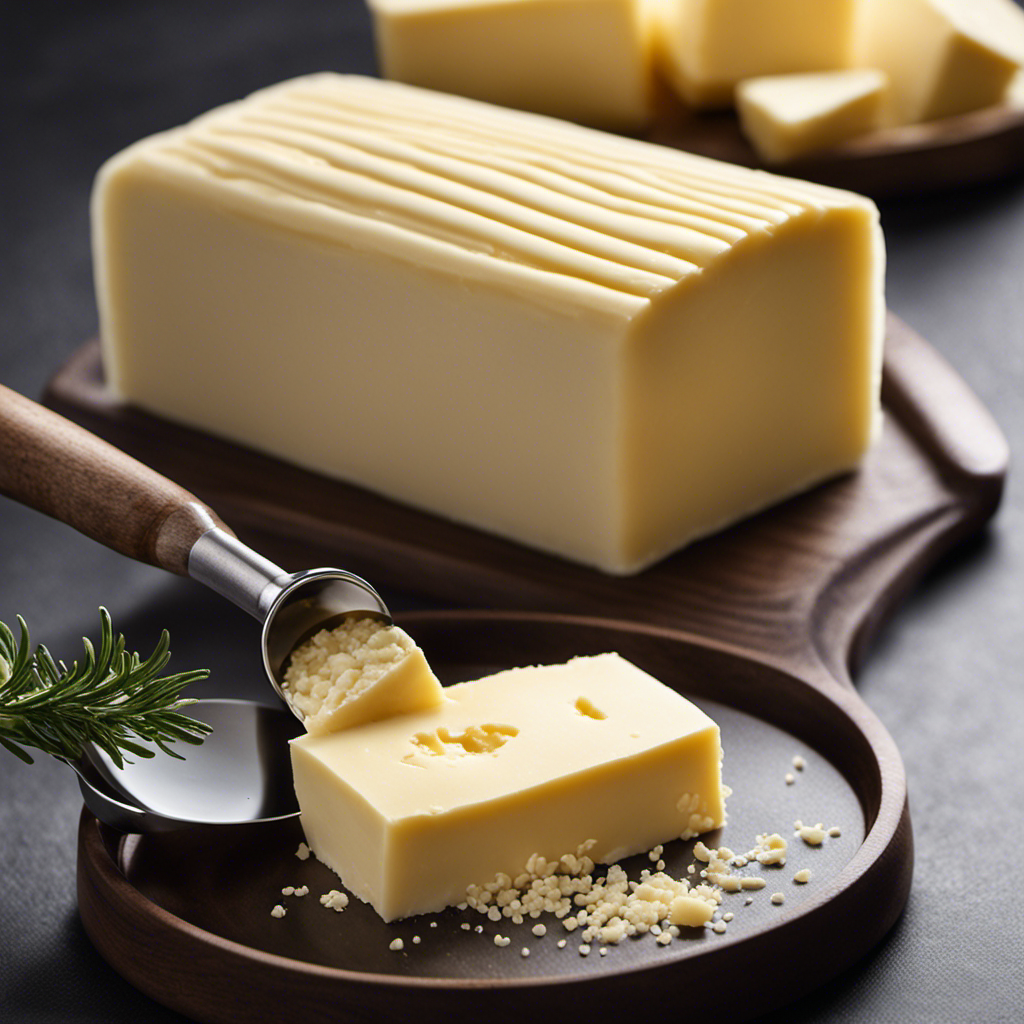They say that knowledge is power, and when it comes to our health, that statement couldn’t be more accurate. As someone who prioritizes health, I’ve always been interested in learning about the sodium levels in various foods.
Recently, I found myself pondering the sodium levels in unsalted butter. How much sodium does it actually contain?
In this article, we will delve into the science behind sodium in unsalted butter, compare different brands, and explore the impact of sodium on our overall wellness.
So, let’s butter up and get started!
Key Takeaways
- Unsalted butter contains around 2 milligrams of sodium per tablespoon.
- Monitoring sodium intake is important to avoid exceeding the recommended daily limit of 2,300 milligrams.
- High sodium intake increases the risk of high blood pressure, heart disease, and stroke.
- Opting for unsalted butter or alternative options can contribute to a healthier lifestyle by reducing sodium intake.
Understanding Sodium Content in Butter
Butter contains a significant amount of sodium, even if it is unsalted. Many people assume that unsalted butter is completely devoid of sodium, but that is not the case. In fact, even the unsalted variety can contain around 2 milligrams of sodium per tablespoon.
This may seem like a small amount, but it can add up quickly, especially if you’re using a lot of butter in your cooking or baking. Sodium plays a crucial role in various culinary processes, such as enhancing flavor, improving texture, and extending shelf life.
However, it’s important to be mindful of your sodium intake, especially if you’re on a low-sodium diet or have certain health conditions. So, keep in mind the sodium content of butter, even when using the unsalted version in your cooking and baking endeavors.
Importance of Monitoring Sodium Intake
Monitoring sodium intake is crucial for maintaining a healthy diet. It is important to be aware of the sodium content in the food we consume as it can have a significant impact on our overall health. Here are a few reasons why monitoring sodium intake is important:
- High sodium intake has been linked to an increased risk of high blood pressure, heart disease, and stroke.
- Excessive sodium consumption can lead to fluid retention and bloating.
- Monitoring sodium intake helps to ensure that we are not exceeding the recommended daily limit of 2,300 milligrams.
The Science Behind Sodium in Unsalted Butter
Sodium content in food is an important topic to understand because it can have significant health implications. In this discussion, we will explore the science behind sodium content in unsalted butter and its potential effects on our health.
Sodium Content Explained
If you’re trying to understand the sodium content, let’s break it down for you. When it comes to unsalted butter, the sodium levels are significantly lower compared to regular salted butter. Here’s what you need to know:
-
Sodium effects: Excessive sodium intake can lead to high blood pressure and an increased risk of heart disease. It’s important to monitor your sodium intake to maintain a healthy lifestyle.
-
Sodium alternatives: If you’re looking for a lower sodium option, you can try using unsalted butter or exploring other alternatives like olive oil or avocado spread.
Understanding the sodium content in unsalted butter is crucial for those who are mindful of their sodium intake. By opting for unsalted butter or exploring alternative options, you can make healthier choices for your overall well-being.
Now, let’s delve into the health implications of sodium to further understand its impact on our bodies.
Health Implications of Sodium
Understanding the health implications of sodium is essential for maintaining a balanced diet and taking care of your well-being. Consuming too much sodium can lead to various health risks, including high blood pressure, heart disease, and stroke.
The recommended daily intake of sodium for most individuals is about 2,300 milligrams (mg), which is roughly equivalent to one teaspoon of salt. However, certain groups, such as those with high blood pressure, African Americans, and people over 50 years of age, should limit their intake to 1,500 mg per day.
It is important to note that sodium is found not only in table salt but also in many processed foods, such as canned soups, bread, and deli meats. Being aware of your sodium intake and making healthier food choices can help reduce the risk of these health problems.
Comparing Sodium Levels in Different Butter Brands
When you’re comparing different butter brands, you’ll notice variations in their sodium levels. It’s important to keep an eye on the sodium content in butter, especially if you’re monitoring your sodium intake. Here are a few things to consider:
- Different butter brands may have different sodium levels due to variations in production processes and ingredients.
- Some brands offer low-sodium options for those who want to reduce their sodium intake.
- Reading labels carefully can help you make an informed choice about the sodium content in butter.
Monitoring your sodium intake is crucial for maintaining a healthy diet. Excessive sodium consumption has been linked to high blood pressure and other health issues.
Transitioning into the subsequent section about ‘unsalted butter vs salted butter: sodium differences’, it’s worth exploring how choosing unsalted butter can help reduce your overall sodium intake.
Unsalted Butter Vs Salted Butter: Sodium Differences
When it comes to comparing the sodium content of unsalted and salted butter, there are clear differences.
Unsalted butter typically contains zero sodium, making it a healthier option for those watching their salt intake.
Additionally, unsalted butter allows for a more pure and natural flavor, while salted butter adds a savory and salty taste to dishes.
Sodium Content Comparison
You can compare the sodium content of unsalted butter to other products to make an informed choice. When it comes to sodium effects on our health, it’s important to be aware of our daily intake. Unsalted butter is a great choice for those looking to reduce their sodium intake.
Here are some alternatives to consider:
- Olive oil: A healthier option that contains zero sodium and is rich in heart-healthy monounsaturated fats.
- Coconut oil: Another sodium-free alternative that adds a unique flavor to dishes and has potential health benefits.
- Avocado: A creamy and nutritious option that is sodium-free and packed with healthy fats and vitamins.
Health Benefits of Unsalted
Consider the various health benefits of choosing unsalted butter alternatives.
When it comes to our health, it’s important to be mindful of the risks associated with consuming too much sodium. Regular butter can be high in sodium, which can contribute to health problems such as high blood pressure and increased risk of heart disease.
By choosing unsalted butter alternatives, you can reduce your sodium intake and lower these health risks. Not only does unsalted butter have less sodium, but it also contains important nutrients like vitamins A and D. These nutrients are essential for maintaining healthy eyesight, strong bones, and a well-functioning immune system.
Flavor Differences With Salted
There’s a noticeable difference in flavor between salted and unsalted butter. Salted butter has a rich and savory taste due to the added salt, while unsalted butter has a more subtle and creamy flavor. The flavor profiles of these two types of butter can greatly impact the taste of your dishes.
When it comes to cooking applications, salted butter is often preferred for savory dishes such as sautéing vegetables or frying eggs. The salt enhances the overall flavor of the dish. On the other hand, unsalted butter is commonly used in baking recipes where precise control of salt content is important. It allows the other ingredients to shine without overpowering them with saltiness.
How Sodium Affects Health and Wellness
It’s important to be mindful of how sodium can impact your health and wellness.
Excessive sodium intake has been linked to various health issues, including high blood pressure and kidney problems. When we consume too much sodium, it can lead to an increase in blood pressure, putting extra strain on the heart and blood vessels. This can eventually lead to cardiovascular diseases, such as heart attacks and strokes.
Additionally, excessive sodium intake can also have negative effects on kidney health. The kidneys play a crucial role in regulating sodium levels in the body. When we consume too much sodium, the kidneys have to work harder to eliminate the excess, which can contribute to kidney damage over time.
Therefore, it is important to monitor our sodium intake and strive for a balanced diet to maintain good health and wellness.
Tips for Reducing Sodium in Your Diet
To reduce sodium in your diet, try using herbs and spices to add flavor to your meals instead of relying on salt. This simple switch can help you lower your sodium intake and improve your overall health.
Here are some tips to help you reduce sodium in your diet:
- When eating out at restaurants, ask for your meal to be prepared without added salt or with reduced sodium options.
- Read food labels carefully and choose low sodium options whenever possible.
- Experiment with different herbs and spices to enhance the flavor of your dishes without adding extra sodium.
In addition to these tips, you can also try out low sodium recipes at home to take control of the amount of sodium in your meals. By making small changes and being mindful of your sodium intake, you can easily reduce the amount of sodium in your diet and improve your health.
Frequently Asked Questions
Can Unsalted Butter Be a Good Option for Individuals With High Blood Pressure?
Unsalted butter can be a good option for individuals with high blood pressure. It is one of the unsalted butter alternatives that can help reduce sodium intake, which has a direct impact on blood pressure levels.
Are There Any Other Health Benefits of Unsalted Butter Besides Its Lower Sodium Content?
Other health benefits of unsalted butter include its high vitamin A content, which supports eye health, and its role in the absorption of fat-soluble vitamins. Additionally, it adds richness and flavor to cooking applications.
Is There a Recommended Daily Intake of Sodium for Adults?
There are recommended daily intake guidelines for sodium in adults. It is important to be aware of these guidelines and monitor our sodium intake to maintain a healthy lifestyle.
Can the Sodium Content in Unsalted Butter Vary Depending on the Brand or Manufacturing Process?
Brand variations and manufacturing processes can indeed influence the sodium content in unsalted butter. Different brands may add varying amounts of sodium, and the manufacturing process can impact the final sodium levels.
Are There Any Other Ways to Add Flavor to Dishes Without Using Salted Butter?
Adding alternative seasonings and exploring flavor-enhancing techniques can help enhance dishes without relying on salted butter. By experimenting with herbs, spices, citrus, or even infused oils, you can create delicious flavors while reducing sodium intake.
Conclusion
In conclusion, understanding the sodium content in unsalted butter is crucial for monitoring our intake and maintaining our health and wellness.
By comparing sodium levels in different butter brands, we can make informed choices.
Unsalted butter offers a lower sodium option compared to salted butter, reducing the risk of health issues associated with excessive sodium consumption.
By implementing tips for reducing sodium in our diet, we can take control of our sodium intake and improve our overall well-being.
So, stay savvy and select unsalted butter for a healthier, happier you!










